He's described in this clipping:
Two little Chinese boys have been adopted by a R.A.F. Spitfire Squadron stationed at Kaitak airfield, Kowloon, Hong Kong. When the squadron took over the airfield from the Japanese, the children, who are brothers, presented themselves at the orderly-room. One could speak English, and he informed the corporal that his father had been murdered by the Japanese, and his mother was seriously ill. A visit was made to the mother, and she was told that her children would be "adopted." She was delighted, and the station medical officer who examined her said that the news may speed her recovery. The children have been named "Biq Wings" (aged eleven) and "Little Wings" (aged eight).
The Imperial War Museum has two more photos:
And:
Here the two boys present arms on the arrival at Kaitak airfield of Air Commodore W A D Brooke CBE, Air Officer Commanding Hong Kong.
There's also a colourised photo of the boys on Facebook, and in the comments Nicholas Chan writes:
"Little Wings" is my grandpa, he is turning 88 this year and he is still living healthily in Hong Kong right now. Even though I moved to the UK I still try to visit him at least once or twice every year. This is a story that has been told numerous times in our family.
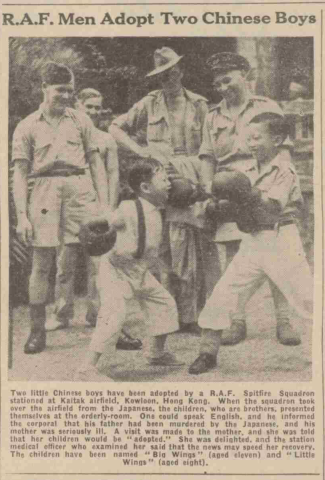
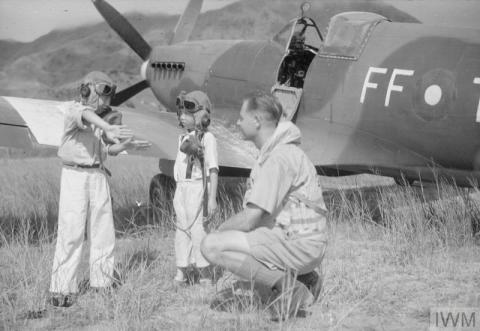
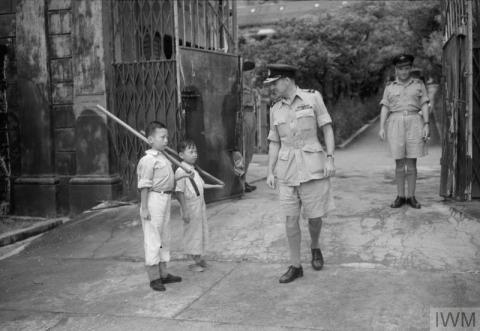
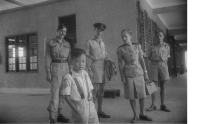
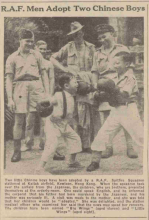
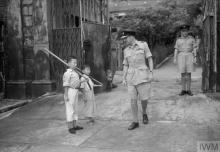
Comments
St. Joseph's Home for the Aged
In the photo above, the two lads are standing to attention outside a main gate. The entrance is to St. Joseph's Home for the Aged. After the end of the Pacific war, the Home was requisitioned and served as temporary quarters for the RAF.
1945 RAF Adopts Two Little Mascots
The photos of "Big Wings" and "Little Wings" are from September 1945. An article regarding the lads appeared in the China Mail dated Tuesday, 25 September 1945 here and copied below:
Who is the proudest man today at Kai Tak ? The answer is, perhaps, CPL Dawber, for upon him has fallen the task of bringing up "Big Wings" and "Little Wings" - two Chinese boys adopted by the Royal Air Force.
"Big Wings" was so christened because of his partiality for the Sunderland flying boats. His proper name is Chan Kwai-Tong and his age is 11 years. Younger brother, Chan Lai-Pun aged 8 years, was given the name "Little Wings" because of his liking for Spitfires.
These two boys stayed near the aerodrome, in a small hut at Shapo, before the war. When the Japanese came they still lived in their hut together with their father and mother, but as "Big Wings" said their father died very soon after December 25, 1941, and they were left to fend for themselves and their mother.
Not being able to make a living, they went to the country but great was their joy when they heard that the Japanese had thrown their hand in. They came back to Hong Kong and once more made their home near the aerodrome.
On September 9, the advance party, R. A. F., arrived at Kai Tak. Memories of the kind treatment they had received from British airmen previously prompted them to try their luck again. They went home armed not only with rice and bread, but also with chocolates and other eats so dear to the palate of the youngsters.
Since then they have not missed a single day at the aerodrome, and now they have been adopted and put on the strength.
They are always on parade and treated as part and parcel of the personnel of the flying field. Two wooden "dummy" rifles, left behind by the Japanese have been cut down to suit their size. These they use in all parades.
They know when an officer comes round they have to "jump to." On Sunday when Air Commodore W. A. D. Brooke visited the aerodrome, they stood smartly at the gate when the officer arrived and presented arms.
Then they laid down their "rifles" and saluted again - the Commodore acknowledging the compliment on each occasion.
And what of the Corporal? He is so proud of his charges that he had the two lads lined up, ready - for a "Press interview," as he said, at the aerodrome yesterday.
Notes:
2. Air Commodore W. A. D. Brooke was appointed Air Officer Commanding Hong Kong on 12 September 1945. He visited Kai Tak on 23 September 1945.
3. Corporal J. Dawber of Wigan
4. Film synopsis: http://www.colonialfilm.org.uk/node/2346